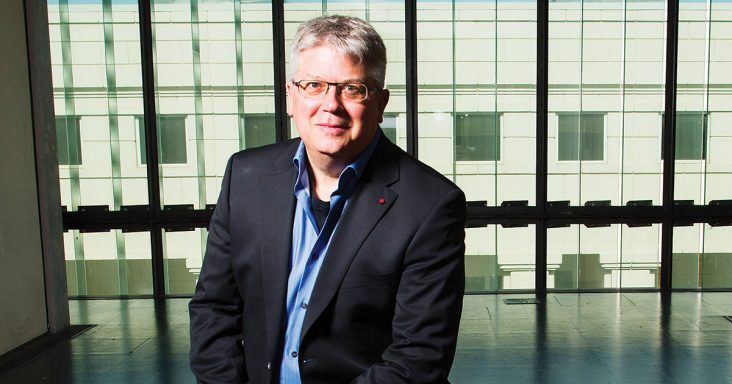Fay Jones School at UA will mark 75th anniversary with multiple events
by February 9, 2021 1:01 pm 836 views

Peter MacKeith, dean of the Fay Jones School of Architecture and Design at the University of Arkansas, was recently named a 2020 Senior Fellow by the Design Futures Council. Appointed in 2014, he's the school's fifth dean. Photography by Wesley Hitt
The Fay Jones School of Architecture and Design at the University of Arkansas will celebrate its 75th anniversary through spring 2022, adding graduate degree programs and building a center showcasing design initiatives for wood and timber.
Founded in 1946, the school now has more than 3,600 alumni, 62 faculty and staff and 730 students across three disciplines: architecture, landscape architecture and interior design.
Dean Peter MacKeith said the alumni have gone on to practice and contribute in the state, across the country and internationally.
“That’s an immense amount of presence in architecture culture,” he said. “One of our graduates equals 10 of anybody else’s — that’s how we view it. To work with real impact throughout our alumni, that’s one significant achievement.”
The school is planning multiple anniversary events, and some have taken place, including a 100th birthday celebration for its namesake, E. Fay Jones. Because of the COVID-19 pandemic, in-person events have yet to be scheduled. However, MacKeith said an in-person gala for alumni would be planned contingent on COVID restrictions. Other anniversary-related events include public lectures, tours of notable buildings in Northwest Arkansas, alumni workshops and an exhibition of alumni work to be viewed virtually and at the school.
MacKeith highlighted the significance of 75 years, especially among schools west of the Mississippi River. Massachusetts Institute of Technology founded the first architecture school in the United States in 1865.
“It’s a very special moment for us as a school but also for the university and the state as we are the only school of architecture and design programs in the state,” MacKeith said. “And we take that responsibility very keenly.”
In January, the school marked the centennial of Jones’ birth by unveiling his American Institute of Architects (AIA) Gold Medal and announcing the publication of the third edition of the “Fay Jones” monograph, with a new forward from Robert Ivy. MacKeith said Jones’ home, which was donated five years ago, has been restored and will become a museum. Jones, a member of the school’s first graduating class in 1950, died in 2004.
In January, Diana “Sue” Hein, daughter of school founder John Williams, donated her family home on Markham Hill. Williams died in 2008.
“I want my father’s legacy to be recognized in this house that he designed, built and lived in,” Hein said. “It signifies a full circle — the way he built the architecture program at the University of Arkansas and this house and how this physical gift of a built house is being given to the school. It’s beautiful symmetry. ‘Poetic’ is the best word to describe this donation, and it represents my recognition of my father’s legacy and my history with the university.”
The school began as a degree program in architectural engineering, and Williams was the sole teacher for architecture courses from 1946 to 1950. It became the School of Architecture in the 1970s when the UA added a landscape architecture program. The interior design program started in the Dale Bumpers College of Agricultural, Food and Life Sciences and became a part of the school in 2010, said Michelle Parks, the school’s director of communications.
GOLD MEDAL FACULTY
Two faculty members have received the AIA Gold Medal, the institute’s highest honor. The recipients include Jones and Fayetteville architect Marlon Blackwell. Jones, an apprentice of Frank Lloyd Wright and designer of Thorncrown Chapel in Eureka Springs, received the award in 1990. Blackwell, the E. Fay Jones Chair in Architecture and distinguished professor in the school, received the award in 2020.
“There’s really no other school of this size and shape and location that can have that claim,” MacKeith said. “A second achievement embodied by those two people is this emphasis on design excellence in education and design excellence in professional accomplishment.
“I’ve been in architecture education since 1980, and it is fair to say that there are schools that go through fallow periods, that go through periods of some stasis,” said MacKeith, who was recently named a 2020 Senior Fellow by the Design Futures Council. “In my estimate, this school has always continued to keep moving forward.”
‘STORY BOOK OF TIMBER’
Design work is underway for the nearly $20 million Anthony Timberlands Center for Design and Materials Innovation. Dublin-based Grafton Architects is designing the five-story, 50,000-square-foot center with Fayetteville-based Modus Studio.

The center will include classroom and studio space for the school and a “state-of-the-art fabrication workshop facility,” MacKeith said. “All of that to be housed within a building designed by arguably the best architects in the world right now.”
Grafton Architects’ co-founders Yvonne Farrell and Shelley McNamara were awarded the 2020 Pritzker Architecture Prize, known internationally as architecture’s highest honor.
“The basic idea of this new Anthony Timberlands Center is that the building itself is a ‘Story Book of Timber,’” Farrell said. “We want people to experience the versatility of timber, both as the structural ‘bones’ and the enclosing ‘skin’ of this new building. The building itself is a teaching tool, displaying the strength, color, grain, texture and beauty of the various timbers used.”
MacKeith said this will be the firm’s first building in North America and will be constructed with wood sourced from Arkansas, one of the top U.S. timber producers.
“The building intends to not only benefit the students in their education but ultimately to benefit the economy and the environment of the state by the wise stewardship of this incredible natural resource and the use of that resource toward the further economic and environmental development of the state,” he said. “This is a very important moment for the southeast of the United States altogether, and Arkansas’ forests figure very heavily in this. And we believe that there is a contribution that we can make as a school to the betterment of the state and the citizens of the state in this effort.”
The center has received broad public and private support, including a $7.5 million gift from UA alumnus John Ed Anthony and his wife, Isabel. Anthony is chairman of Bearden-based lumber producer Anthony Timberlands Inc.
MacKeith expects the design to be completed over the summer and for construction to begin this fall. The center is expected to open in fall 2023. Nabholz Construction Corp. was selected as the general contractor. In 2019, it completed the largest mass timber project in the United States, Adohi Hall — a 202,027-square-foot residence hall constructed from cross-laminated timber adjacent to Bud Walton Arena.
The new center also will be home to the school’s emerging graduate program with a concentration in integrated wood design.
HEALTHCARE, WELLNESS FOCUS
Another graduate degree program will be in healthcare and wellness. UA alumnus Greg Roberts, who spent more than three decades in healthcare design, recently gave $1 million to establish an endowed chair to direct the proposed program.
It will provide professional preparation in healthcare design and focus on addressing critical issues in the state and benefiting residents’ overall health, MacKeith said. That might include retrofitting homes as occupants age or relate to workplaces, including office environments and schools.
The design will focus on building qualities in a post-pandemic world, including materials choice, ventilation systems, and how workers will sit and interact with each other. Best design practices for clinics and hospitals, including surgery rooms, also will be addressed in the program.
Curriculum development is expected to start this spring, and student enrollment might begin as soon as spring 2023.
